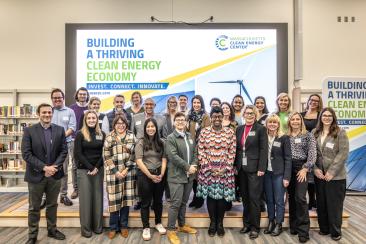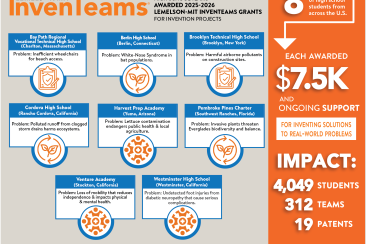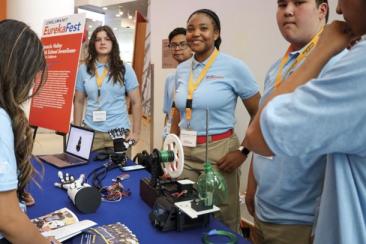Top Student Inventors Awarded 2018 Lemelson-MIT Student Prize
Following a nationwide search for the most inventive college students, the Lemelson-MIT today announced the winners of the 2018 Lemelson-MIT Student Prize.
CAMBRIDGE, Mass., April 10, 2018 – Following a nationwide search for the most inventive college students, the Lemelson-MIT Program today announced the winners of the 2018 Lemelson-MIT Student Prize. The Program awarded a total of $80,000 in prizes to 14 undergraduate and graduate student inventors, selected from a large and highly competitive pool of applicants from across the United States. Students were selected based on a variety of factors including: the overall inventiveness of their work, the invention’s potential for commercialization or adoption, and youth mentorship experience.
The Lemelson-MIT Student Prize is supported by The Lemelson Foundation, serving as a catalyst for young inventors in the fields of health care, transportation and mobility, food/water and agriculture, and consumer devices.
“This year’s Lemelson-MIT Student Prize winners are the embodiment of the inventive spirit,” said Stephanie Couch, executive director of the Lemelson-MIT Program. “They have not only invented solutions to real-world problems, they are also paving the way for their peers through their mentorship. We’re excited to share their accomplishments and to continue seeing them grow as Lemelson-MIT winners.”
“These students represent a new generation of inventors with big ideas on how to improve healthcare, agriculture, mobility, and scientific discovery,” said Dorothy Lemelson, board chair of The Lemelson Foundation. “They are an inspiration to their communities and we’re proud to honor their accomplishments.”
2018 Lemelson-MIT Student Prize Winners
The “Use it!” Lemelson-MIT Student Prize: Rewarding technology-based inventions that involve consumer devices.
The AssistENT team developed N-Stent, a comfortable and discreet nasal dilator designed to improve breathing for those who suffer from nasal obstruction. Unlike existing external nasal dilators, N-Stent is inserted into the nose, making it undetectable and comfortable for wear during the day or night.
Kayla developed the EMPAD, a fast, highly-efficient detector that enhances imaging for a range of microscopic applications. The detector is a special camera designed to detect and display electrons in microscopes at a much greater level of detail than existing versions. This detailed data can be utilized to make faster computers, more effective drugs, more advanced electric cars, and can even aid with art conservation.
The “Eat it!” Lemelson-MIT Student Prize: Rewarding technology-based inventions that involve food/water and agriculture.
Maher developed a polymer additive that can be mixed with pesticides and other agricultural sprays to help them adhere to plants more effectively. Plants currently retain only a tiny portion of chemical sprays, resulting in runoff that leads to the contamination of soil, ground water, and surface water. Maher’s invention would result in the use of 10 times less pesticides and could save farmers 10-20% of their total production costs.
The “Cure it!” Lemelson-MIT Student Prize: Rewarding technology-based inventions that involve health care.
The Treyetech team developed a device to help surgeons successfully perform corneal transplant surgery. About three million Americans are at risk of corneal diseases, but surgeons are hesitant to perform the only procedure that can restore vision to 20/20 because of a challenging and sometimes unsuccessful portion of the operation that involves unrolling a delicate cornea tissue graft into a patient’s eye. The Treyetech team has created a device that prepares and transports the donor cornea graft from an eye bank to surgeons, eliminates the unrolling step, and allows for more effective and successful insertion into the eye.
Tyler developed a new approach to amputation called the Agonist-antagonist Myoneural Interface (AMI), which is comprised of a novel surgical technique for limb amputation and a complementary prosthetic control system. The AMI is unique in its ability to provide patients with proprioception, or the sense of the relative positioning of their prosthetic body parts in space, which is not possible in the current clinical standard of care. In this way, the AMI enables persons with amputation to receive feedback of joint position, speed, and torque from their brain-controlled prosthetic limb, improving their ability to perform everyday tasks and enabling them to feel as though their prosthesis is truly a part of their body.
The “Drive it!” Lemelson-MIT Student Prize: Rewarding technology-based inventions that involve transportation and mobility.
Guy invented All Photons Imaging, a system that can image through dense fog, intended for augmented driving, autonomous vehicles, drones, airplanes, and helicopters. The system computationally removes dense fog from camera images in order to produce an image as if the fog were not there. Seeing through obstructions helps avert great danger for the various modes of transportation to which this system can be applied, and the invention has useful applications in other fields, such as providing enhanced medical imaging.
Watch the 2018 Student Prize Winner Video





